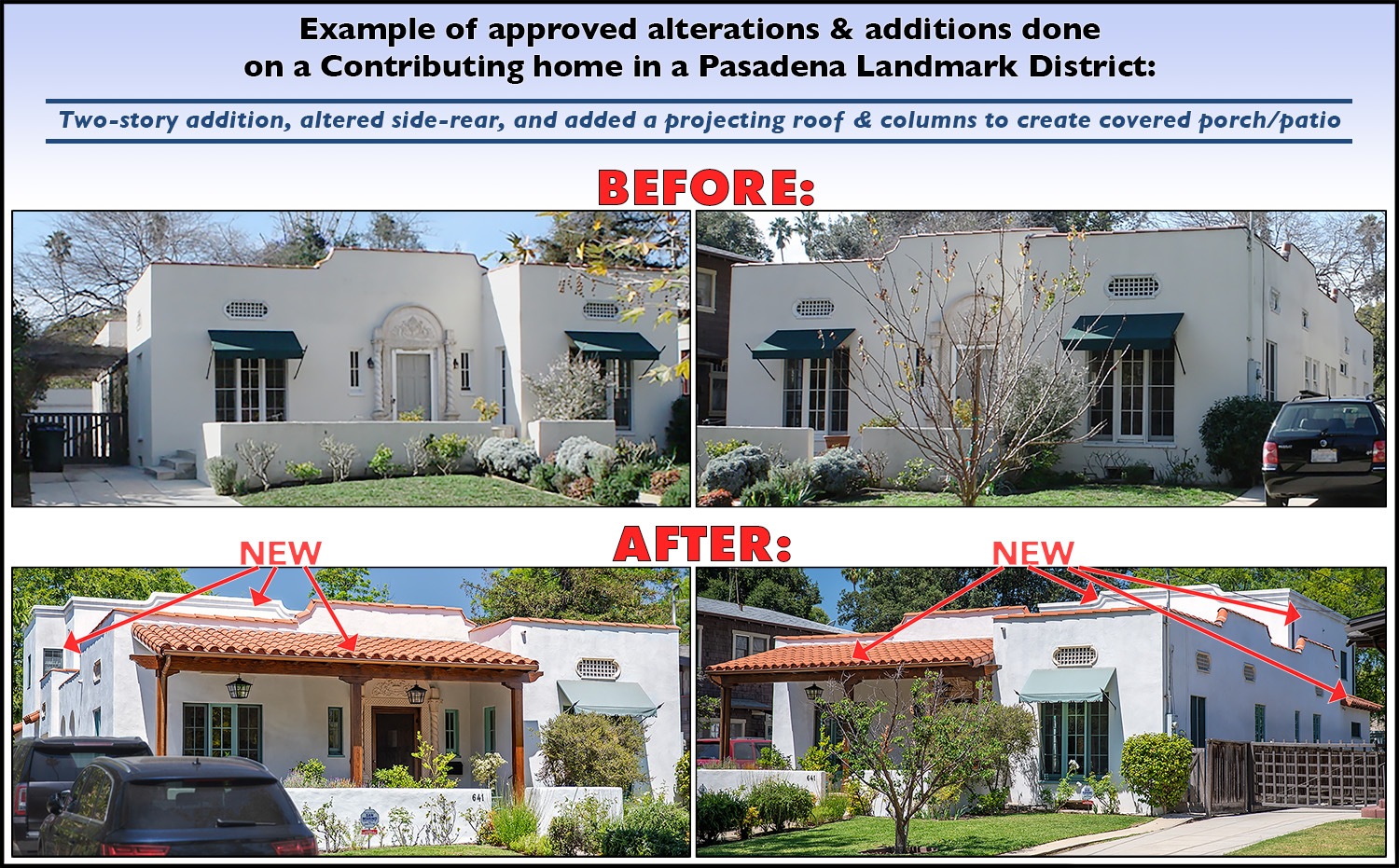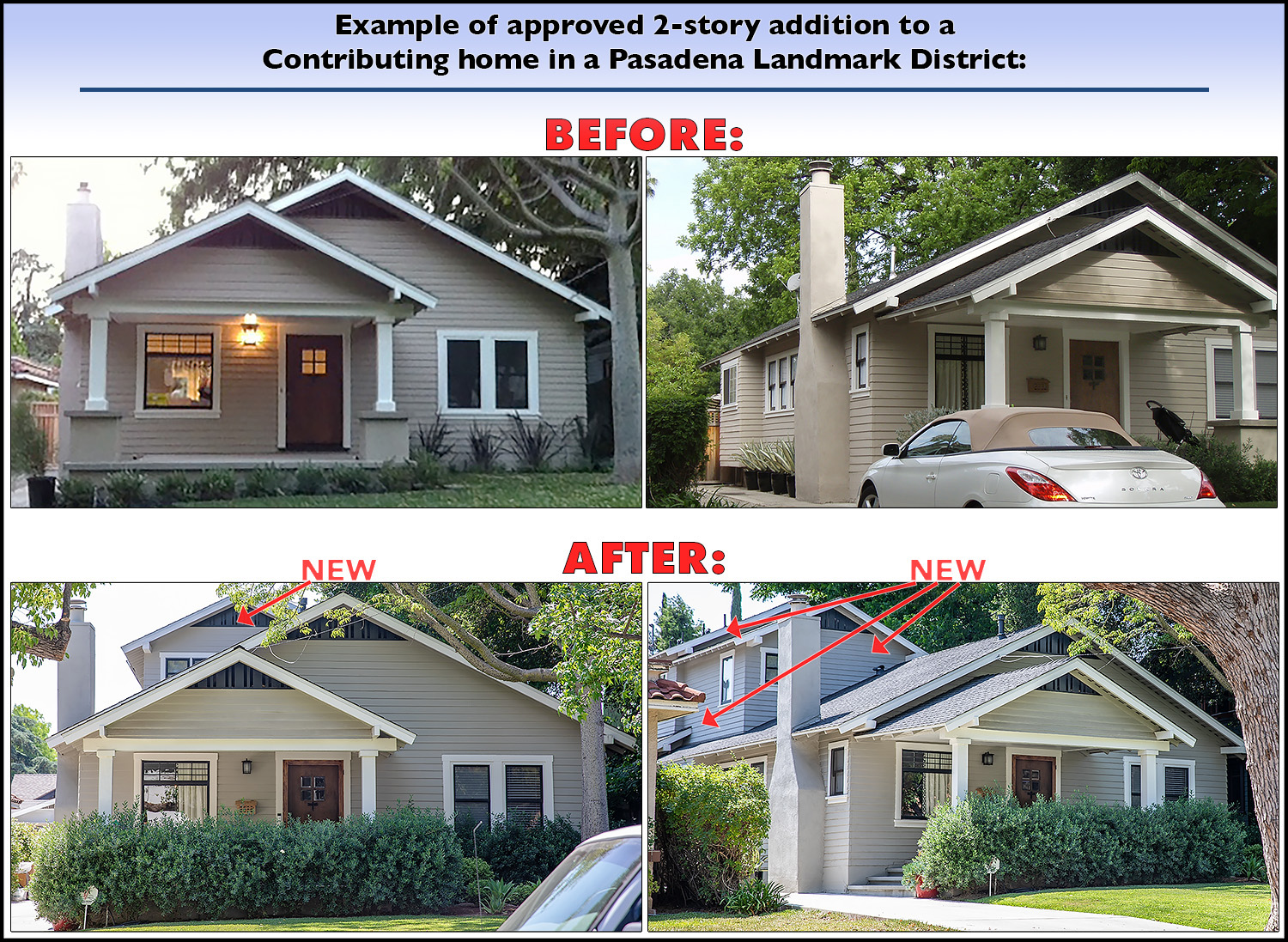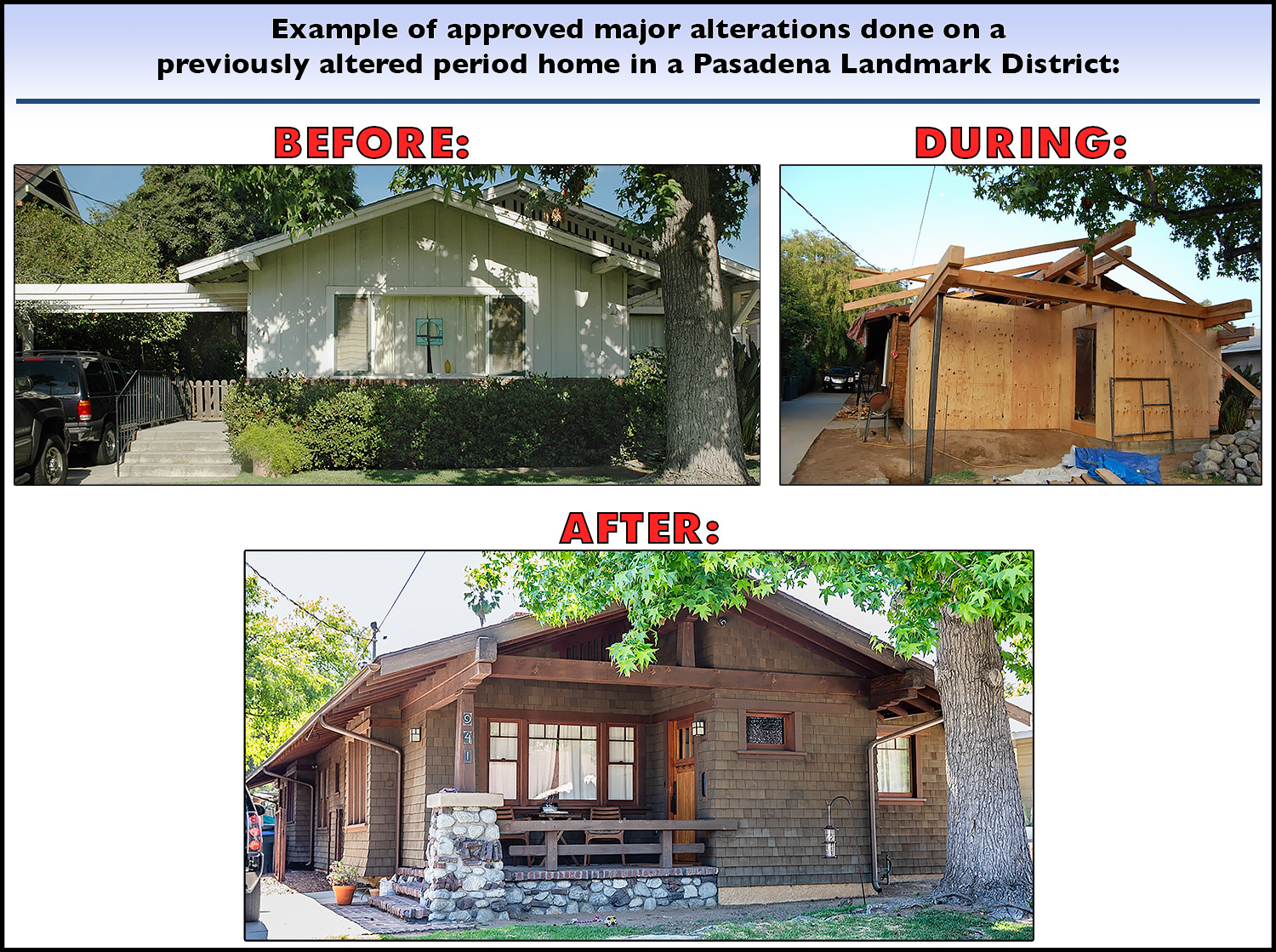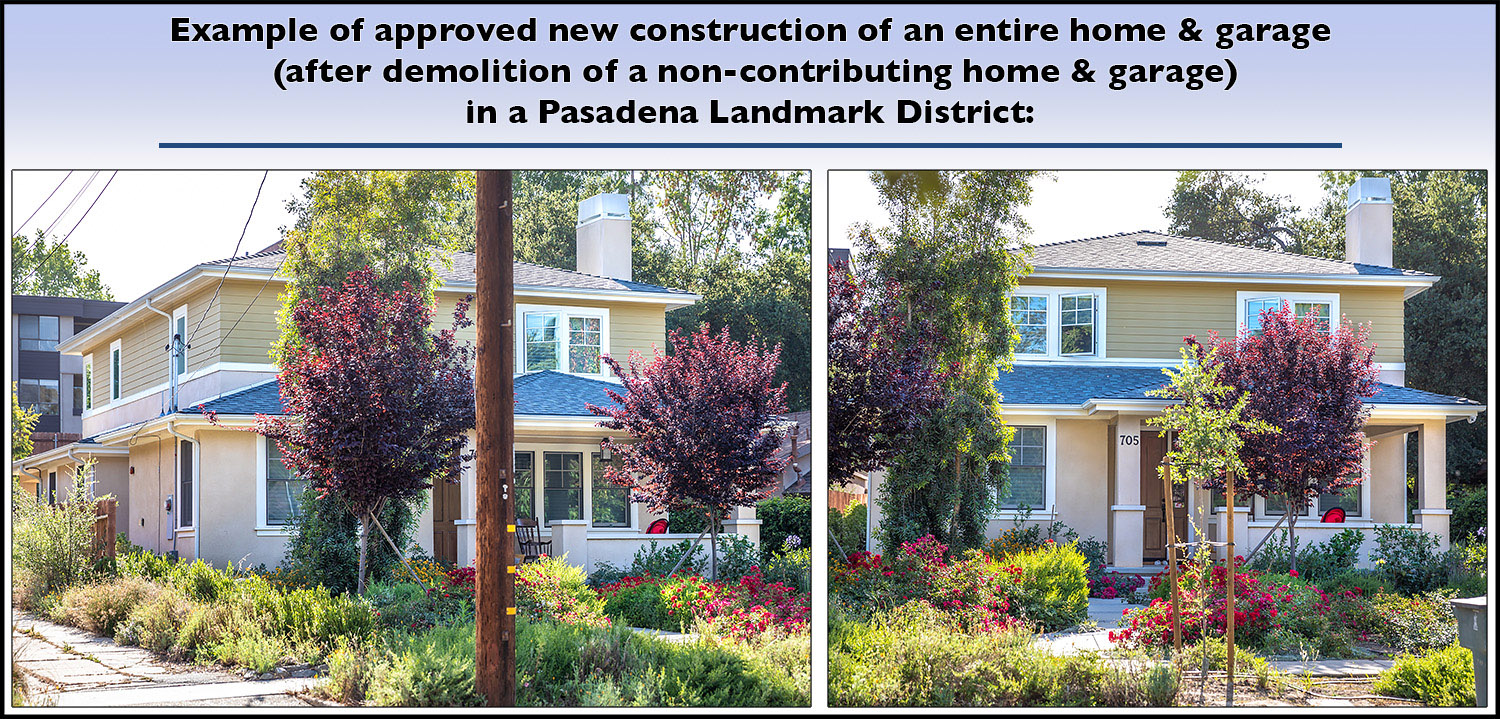Note: The City of Pasadena requires an Architectural Survey to be conducted of all homes within the proposed Landmark District. This Survey only notes exterior architectural stylistic details publicly visible from the sidewalk, and includes photos similar to Google Maps for City records. This is a time-consuming task, so if you see one of our surveyors out there, please be kind! If you have any questions, please email us and we can share more info or connect you with City staff.
Save our neighborhood’s historic architecture!
We have been actively working on becoming a landmark district since 2018 (with a signature-gathering delay during the height of the pandemic), to protect the significant historic architecture that makes our neighborhood and city so special. Becoming a landmark district is the only way we can protect this unique and beautiful historic character of our neighborhood.
The City of Pasadena’s long-standing process for designating historic districts (which the City calls “landmark districts”) is highly rigorous, using essentially the same clear standards the federal government uses for historic districts. “Landmark district” and “historic district” are basically synonymous terms, the key distinction here being which body performs the designation (the City or federal government).
CLICK HERE to see if you’re on the proposed LANDMARK DISTRICT MAP
Please scroll down this page for more info and answers to most questions.
Unless Madison Heights becomes a landmark district…
Architectural taste is subjective, and this is not a judgment of any particular home. This one would fit in well in various places. But it is quite incongruous amongst the historic homes and bungalows that make the Madison Heights neighborhood so unique, beloved and inviting. It could not go up next to you in a landmark district.
It’s also worth noting that the new State law (known as SB 9) poses another threat to historic architecture by overriding our neighborhood’s zoning to allow the demolition of nearly any home and up to 4 new units to be built on a lot (with a lot split, depending on size), while reducing setbacks. (More info in FAQ #2 below.) But landmark districts (aka historic districts) are exempt, in order to protect such historic resources.
SB 9 specifies an exemption “within a site that is designated or listed as a city or county landmark or historic property or district pursuant to a city or county ordinance.” By specifying “city” rather than “federal,” SB 9’s language clarifies that it is referring to the city’s landmark districts, since they’re the historic districts the city designates.
WHAT THIS MEANS:
Anyone could sell their home, and regardless of historic architectural significance and value for the public, the new owner/developer could potentially demolish it (with few exceptions) and replace it with up to 4 new homes/condos/apartments (within 4 feet of neighbors’ property line). Note that the State law has no requirements for affordability. This is a boon for developers, and could be a death knell for beautiful, historically significant architecture.
However: the State recognizes the civic and cultural importance of protecting historic architectural resources, and thus SB 9 includes an exemption for landmark districts (aka historic districts) and other historic landmarks.
The City of Pasadena and the Madison Heights Neighborhood Association strongly support increasing much-needed affordable housing in the City. We also support the addition of ADUs and JADUs in single-family residential neighborhoods like ours, for which the City offers incentives. These are permitted in landmark districts.
TAKE ACTION NOW - IT’S FAST!
Is your home in the Proposed Madison Heights Landmark District? (Click the map to find out:)
If so, PLEASE SIGN THE PETITION to designate the Madison Heights Landmark District. Click the button to request the petition:
The proposed area on the map is already an “eligible” landmark district, but to become a designated landmark district with full protections, a majority of property owners must sign the landmark district petition.
This means your signature is needed now to help protect our special neighborhood.
If you don’t sign the petition, that will count as a vote against the landmark district.
Want more info? Have questions? Check our FAQ below
NEXT STEPS:
You can still click the button below to arrange for the petition to be brought to you! For those who don’t email:
Individual petition pages will be dropped off or mailed to the remaining homeowners who haven’t signed.
PLEASE look out for this, and sign and return that page right away when you get it.
Or better: just click the button to ask us to bring the petition to you ASAP:
- If you support becoming a landmark district:
Please click to email ASAP to ask for the petition. Someone will arrange to bring it to you at your convenience. If we don’t hear from you, a physical petition will be sent. For properties with more than one owner, ALL owners must sign for the property to be counted as a "yes.",
- If you don't support MHLD:
You don’t have to do anything. Not signing the petition will count as a "no" vote. But please click to email to let us know so we won’t later drop off or mail a physical petition, and feel free to share your concerns in your email. All voices should be heard, and if any concerns can be addressed, we or the City are happy to help.
- If you're not sure and have questions:
Please check the FAQ below or click to email ASAP with any questions you have. All questions are good questions! We’ll be happy to answer.
- If you'd like to help the effort:
Right now the best way is to encourange neighbors to email and ask to sign the petition ASAP (or to get more info)! Later, we will need help gathering basic house history info and taking photos of homes for the final approval process. Please click to email indicating you'd like to help. Thank you!!
- If you'd like to receive periodic email updates on the process:
Please send an email indicating you'd like updates. Your email will not be shared or visible to others, and you can request removal at any time.
MORE INFO:
There are over 25 landmark districts in Pasadena, and our neighborhood has been deemed eligible by the City to become one of them. In fact, we already have 4 single-block landmark districts within the area of the proposed MHLD: South Madison Ave Landmark District, South Hudson Ave Landmark District, South Oakland Ave Landmark District, and the recently-designated Magnolia Ave Landmark District.
The purpose of a landmark district is to recognize, maintain, and protect the unique historical architectural qualities and ambience of the neighborhood. Being designated a landmark district enhances both the value of a neighborhood's properties and its identity as a special neighborhood with its own character. It's also a valuable tool to help curb “mansionization.”
Additions, alterations and new construction on our properties can still occur, while historic features are protected.
A design review process helps ensure that exterior structural work which is visible from the street is in keeping with the character and scale of the area. (More info in FAQ below.)
The risk is growing. Pasadena has over 45 areas that are either landmark or National Historic Register districts. Flippers are running out of desirable neighborhoods where they can demolish historically significant (and other) homes and erect “McMansions” or other incongruous structures. Also, many residents are older and may move at any time.
Each turnover is a risk. The sooner we become a landmark district, the more we can protect.
FAQ
Find answers to the most common questions by clicking on them:
1. What IS a Landmark District? Are we already? (Is a "Historic District" something else?)
A landmark district is an area that is recognized for the special quality found in its historic architecture, and this neighborhood character is protected by requiring any exterior structural changes that would be publicly visible from the street to go through a design review process, to ensure that changes won’t compromise the historic architecture. Publicly visible additions can be made in a landmark district — even second stories — but they must be in keeping with the home’s design. There are over 25 landmark districts in Pasadena (and counting), and we are eligible to be one of them. Visitors come from all over to take tours within our neighborhood and several others, where so many notable architects built significant homes and many beautiful styles are on display. One way to think about this is as an insurance policy, ensuring that the neighborhood will preserve its special historic character.
While landmark district are designated by the City, "Historic Districts" (aka “National Register Historic Districts”) are federally designated by the National Park Service. This isn't currently relevant to MHLD, but here's a link to more info at NPS.gov. Note: It is possible to be both a landmark district and a National Register Historic District (e.g., parts of Bungalow Heaven).
We are already an "eligible" landmark district, which means the protections and rules related to major exterior home projects already apply to us. But this does not afford us all the protections of being a full-fledged designated landmark district — including protection from the new State law SB 9, as explained in #2 below). And the protections and rules for "eligible" landmarks might diminish in 2022, which makes designation even more important.
2. WHY IS IT A GOOD IDEA? WHAT ABOUT THE NEW STATE LAW?
It is a valuable tool to curb “mansionization” and to protect the overall character of our neighborhood. Remodeling and additions may still be done on "Contributing" (see below for definition) historic homes in a landmark district, while maintaining their exterior character as seen from the street. Brand new construction is encouraged to be of a similar scale and in the general character of the surrounding houses, but specific architectural style is not regulated.
ALSO: now that State Senate Bill 9 has become law, as of January 2022 State law overrides our local zoning laws in single-family neighborhoods and allows demolition of homes (with few exceptions) and for 2 units to be built on a lot, or 4 units by splitting the lot (if each subsequent lot is at least 1,200 sq. ft.), with reduced setbacks of just 4 feet from the side and rear lot lines.
What this means is that your neighbors could sell their home, and REGARDLESS OF HISTORIC ARCHITECTURAL SIGNIFICANCE, the new owner/developer could demolish it and you could end up with up to 4 new homes/condos/apartments within 4 feet of your property line.
However, the law includes an exemption for landmark districts (aka historic districts) and other historic landmarks, in order to protect them and other historic resources of architectural and cultural significance.
The State law does not have any requirement for affordability, and these new units are unlikely to be, here. This is a boon for developers, though, and could be a death knell for beautiful, historically significant architecture. (Homes can't be occupied as rentals for 3 years prior to demolition per SB 9.)
3. HOW DOES IT AFFECT MY HOUSE?
It does not affect the use or sale of your home. There are no requirements to do anything to alter your home. It only potentially affects certain exterior, publicly visible changes made to our homes in the future.
4. WHAT KINDS OF CHANGES WOULD BE REVIEWED? CAN I SEE EXAMPLES?
Major remodeling or new construction plans are reviewed before a permit is issued. The review focuses on what is visible from the street (alleys don't count as streets), in order to help preserve the historic character and materials where possible. This includes alterations to street-visible windows, doors, porches, fences, garages visible from the street, etc. Projects like the huge concrete house amongst California bungalows on Los Robles, south of California, would not be permitted.
A landmark district should be dynamic, allowing changes that are compatible with modern needs while ensuring an overall sense of visual continuity. See the slideshow below for Before & After photos of 5 homes that have had extensive work approved within Pasadena landmark districts.
5. WHAT IS NOT REVIEWED IN A LANDMARK DISTRICT?
Examples include: exterior alterations that are not publicly visible from the street (alleys are not considered streets in this context), paint and stain colors, interior alterations, landscaping, hardscape, screens and awnings, solar panels, lighting, reroofing (except for a change of material), and routine maintenance and minor repairs. Most normal City zoning and building laws still apply.
6. WHAT ABOUT NEWER HOMES?
(I.e., homes built after the mid-40s, give or take — specific dates for the period of significance of this district TBD.)
Newer homes (along with older homes that have been so significantly altered that they no longer retain their original exterior appearance) are considered “Non-Contributing” to what makes the district architecturally and historically significant. For them, minor alterations do not require design review. Demolition and rebuilds are considered major, and new construction should maintain similar setbacks, scale, rooflines, primary exterior materials (in appearance, if using newer materials), etc. to the Contributing homes in the neighborhood. Again, specific architectural style is not regulated.
7. WHAT ARE "CONTRIBUTING" / "NON-CONTRIBUTING" PROPERTIES?
As noted above, Contributing properties are those that were built within the period of historical significance in a landmark district (in MHLD's case, this will likely be up through the mid-1940s or so), and have largely retained their original exterior appearance. Non-Contributing properties are those built after the period of historic significance, or older homes that have been dramatically altered (as visible from the street).
8. IS IT HARD TO GET HOME IMPROVEMENT PERMITS IN A LANDMARK DISTRICT?
There are no additional fees. The design review (application for a Certificate of Appropriateness) will delay a building permit by about 6-10 weeks on average. Working with the City staff in the early design stage simplifies the process, and typically results in approval. Decisions may be appealed. Design guidelines follow basic standards for historic preservation from the Secretary of the Interior, for what is visible from the street.
9. WHAT DESIGN GUIDELINES ARE USED IN A LANDMARK DISTRICT?
There are several sources for the guidelines used by the Historic Preservation Commission, but they're simpler than they may seem at first. This page will also explain some of the common terms used in the guidelines, such as "guideline," "consider," "should," "preferred," "appropriate," "inappropriate," etc.
The first thing to know is that the Pasadena Zoning Code overrides all other sources. Its section on Historic Preservation / Landmark Districts specifies which types of work require review for which sorts of properties (see below). After that determination, details for design guidelines can be found in the City's publication, Design Guidelines for Historic Districts. It seems like a long document at first glance, but most of its contents are just general background information rather than guidelines (e.g., descriptions of architectural styles, details about designated Pasadena landmark districts, tips on how to prevent wood from deteriorating, etc.). Also, many of its guidelines do not apply to landmark districts, and can be disregarded (e.g., sections on driveways, parkways, retaining walls, lighting, etc.). Again, that's because the Zoning Code overrides it.
The Design Guidelines document is based on the The Secretary of the Interior's Standards for Rehabilitation & Illustrated Guidelines for Rehabilitating Historic Buildings, put out by the National Park Service. This may also be referenced for some details where relevant, though it too is a lengthy document with many sections that don't apply to Pasadena landmark districts.
Again, the Zoning Code is the overriding document for what is and is not reviewed. It reads:
- 17.62.090 (B) (4): Exterior work subject to regulatory review of an application for Certificate of Appropriateness in designated or eligible landmark districts and designated or eligible historic districts is limited to public view from public and private streets; views from alleys are excluded from review.
- 17.62.090 (B) (6): In landmark and historic districts outside the Central District, the following items shall be exempt from review: Paint colors and stains, routine maintenance and minor repairs, landscaping (except for trees protected under Chapter 8.52 - Tree Protection), all interior alterations, screens and awnings, flat concrete work (including driveways and walkways), rear yard walls and fences, reroofing (except for a change of material), exterior lighting fixtures, and window/door grilles.
10. HOW ARE OUR PROPERTY VALUES AFFECTED?
Numerous studies show that being in a landmark district tends to increase home values (sale price) at a higher rate than homes in similar, non-LD neighborhoods. Many buyers seek the unique qualities and ambiance of a landmark district, and the assurance that they can reinvest in improvements without fear of a neighbor undermining their investment with inappropriate new development.
11. ARE PROPERTY TAXES AFFECTED?
Landmark district status does NOT affect the current assessed value of your property for tax purposes (i.e., it does not raise your tax rate). In fact, if you qualify, you may be able to reduce property taxes through The Mills Act. See more about that below, under the question: "Are There Any Other Benefits?"
12. ARE THERE ANY COMPELLING REASONS AGAINST BECOMING A LANDMARK DISTRICT?
For most residents in potential landmark districts, no. As most see it, any potential downside is far outweighed by the substantial short- and long-term benefits. There are few objections, most of which tend to be based on understandable confusion about what landmark districts in Pasadena involve — such as concerns that it would restrict paint colors, landscaping, hardscaping, or interior work, or outright ban second-story additions or other expansions, etc. (None of which is true, for the record.)
However, there are a few objections that some well-informed people do have:
1) The permit process (for exterior work that's visible from the street) takes a little longer in a landmark district, due to the design review to get a Certificate of Appropriateness. For most homeowners, that's a minor, temporary inconvenience (6-10 weeks on average) that can be planned for, and worth it for the benefit of protecting their additional investment in their home — as they can rest assured that their property value and quality of life won't be diminished by a neighbor destroying a Contributing historic home to put up 4 new units or an otherwise incongruent monolith such as the one pictured below on Los Robles. Working with the Design & Historic Preservation staff in the early design stage simplifies the process, and typically results in approval. 2) Some people simply don't like the idea that the City may have any further input on what they do to the front of their house. While that is perfectly understandable, without some reasonable, long-standing standards, there is simply no other way to protect the integrity and charm of our special neighborhood from those who want to tear down historic homes or otherwise destroy it. It's this very charm that attracted most of us to live here in the first place. Many of us feel we have a duty to help keep it up not only for ourselves, but for the city as a whole, and for future generations. 3) Some people don't care at all about the historic significance and beauty of the architecture in our neighborhood, and are fine with destroying it. Alas, it's this outook most residents want to protect against.
13. ARE THERE ANY OTHER BENEFITS?
Yes, there are some incentives for preserving Contributing homes in landmark districts. These include: potential reduction of building permit fees and construction tax for various types of exterior repair, replacement, or restoration projects, and for seismic reinforcement and other structural stabilization and repair. Also, when adding floor area to a house, a waiver of the requirement for two-car covered parking may be requested if an existing one-car garage contributes to the significance of the property and/or district.
For property owners interested in applying for the Mills Act tax reduction program for historic properties, being in a landmark district makes that possible (otherwise, the property must be in a National Register Historic District, or individually designated as a landmark or historic monument, or be a Greene & Greene property). The Mills Act allows qualifying properties to potentially receive a property tax reduction, so its owners can use the savings to help rehabilitate, restore and/or maintain their properties. The Mills Act is the single most important economic incentive program in California for the restoration and preservation of historic buildings. If your home is assessed at $1.5 million or less (with a couple exceptions), and you submit a 10-year plan for home improvements, your taxes may be significantly reduced.
14. OKAY, MHLD HAS BEEN PROPOSED, WHAT DO I DO NOW?
If you support becoming a landmark district:
Please email ASAP to ask for the petition. Someone will arrange to bring it to you at your convenience. If we don’t hear from you, a physical petition will be sent. For properties with more than one owner, ALL owners must sign for the property to be counted as a "yes.",If you don't support MHLD:
You don’t have to do anything. Not signing the petition will count as a "no" vote. But please email to let us know so we won’t later drop off or mail a physical petition, and feel free to share your concerns in your email. All voices should be heard, and if any concerns can be addressed, we or the City are happy to help.If you're not sure and have questions:
Please email ASAP with any questions you have, and study the information on this site. All questions are good questions! We’ll be happy to answer.If you'd like to help the effort:
Right now the best way is to encourage neighbors to email and ask to sign the petition ASAP (or to get more info)! Later, we will need help gathering basic house history info and taking photos of homes for the final approval process. Please email indicating you'd like to help. Thank you!!If you'd like to receive periodic email updates on the process:
Please send an email indicating you'd like updates. Your email will not be shared or visible to others, and you can request removal at any time.
See "NEXT STEPS" below for more on the process.
15. WHAT ARE THE NEXT STEPS TO OBTAINING LANDMARK DISTRICT STATUS?
Neighborhood homeowners began canvassing for signatures, but were halted by the pandemic. Now we’re asking homeowners to email us to bring the petition directly to them. Then we’ll mail individual petition pages to those who haven’t responded. Then an application will be submitted to the City, along with signatures and documentation of our neighborhood. There will then be 3 separate public hearings to review and approve the application: Historic Preservation Commission, Planning Commission, and City Council. A majority of the property owners within the final proposed MHLD boundaries would have to have expressed support, by signing the petition. Note that for properties with more than one owner, all owners must sign for the property to be counted as a "yes."
16. WHAT ABOUT THE 4 EXISTING LANDMARK DISTRICTS THAT FALL WITHIN THE WIDER BOUNDARY OF MHLD?
The homeowners in these single-block LDs will be presented with a different petition. It will ask whether they wish to become part of the larger MHLD if/when MHLD is approved. No matter what happens, there will be absolutely no change to their status as Landmark Districts, and their already-established protections will remain the same. The main advantages to joining together would be neighborhood cohesion and identity, and having one Landmark District in the area with cleaner, unified boundaries that’s easier to manage. Also, attractive street signs identifying the Madison Heights Landmark District would apply to the whole, and enhance our neighborhood's identity.
17. HOW WILL MHLD COMPARE WITH OTHER LANDMARK DISTRICTS THROUGHOUT PASADENA?
MHLD will be the second-largest Landmark District in the City. Bungalow Heaven is the largest, with 1,139 properties – quite a high bar to reach! Historic Highlands is currently second, with 479 properties. MHLD (as currently proposed) would have approximately 740 properties. And we'd be the smartest and best-looking, naturally. :)
18. HOW WAS THE PROPOSED MHLD MAP DRAWN?
Note: the boundaries may change during the petition process, as some properties may be added or removed from the currently proposed Landmark District. Advance notification of changes to the current proposed boundaries will be publicized prior to the first public hearing following the petition signing process.
The current proposed boundaries (see map in sidebar or below) were drawn based on the largest contiguous collection of homes that are of historic significance and add to the unique character of the neighborhood — and by extention, of the City. (See further explanation of "Contributing" properties under that heading, above.)
In the early stages of assessing eligible homes for this proposed Landmark District, the idea of some residents was to include many blocks that fall within both the Madison Heights and Oak Knoll Neighborhood Association's areas. It would have gone by a different name, since Landmark Districts are unrelated to neighborhood associations. However, the area would have been considerably large and taken much longer to get approved, so a more managable area was settled upon. Several blocks near the borders were nonetheless deemed eligible by the Design & Historic Preservation department during the final assessment (outlined in gray on the current proposed map), and while they're not currently included, they would be if those (or more) owners requested. (The final name of the Landmark District would then likely reflect that.)
19. WHAT DO LOCAL REALTORS THINK ABOUT LANDMARK DISTRICTS?
More quotes are coming very soon, please check back soon!
“Personally, I think a Landmark District lends to increasing a property's value and helps to establish a specialness or uniqueness in a neighborhood. It also offers a huge marketing advantage to me when I am selling a property with Landmark District status. Often, buyers from elsewhere in L.A. County who might not really know Pasadena or how special it is, will be drawn to a house in a Landmark District and view it as more interesting and intriguing. A Landmark District also helps keep the standards of the neighborhood up.
“Moreover, if a home is in a Landmark District, it can really aid in the process of getting approved for the Mills Act, which greatly reduces property taxes for the homeowner. For those who want to pursue that avenue may see this as a big positive.”
— Chelby Crawford, Coldwell Banker Global Luxury Certified Specialist Realtor & Relocation Specialist CalDRE#: 01399237
“Becoming a Landmark District is worth it. They’re a good thing in Pasadena. Great historic homes help make a neighborhood like Madison Heights special. When one is destroyed, and something terribly incongruous goes up in its place, it diminishes the neighborhood. Nobody wants to live near such homes. We’ve seen situations where it’s very hard to sell. A Landmark District helps protect a neighborhood. Also, property values go up.”
— Charles “Chuck” Livingstone, Coldwell Banker Global Luxury Certified Specialist Realtor (for over 22 years) CalRE# 01203399 realtor@chucklivingstone.com • 626-641-1264
20. WHO ARE SOME OF THE SIGNIFICANT ARCHITECTS WHOSE WORK IS IN THE PROPOSED MHLD?
- Greene & Greene
- Arthur & Alfred Heineman
- Wallace Neff
- Frederick L Roehrig
- David M. Renton
- Sylvanus Marston (working from a Frank Lloyd Wright design in one case)
- John William Chard
- Reginald Davis Johnson
Please submit any further questions you have, and we’ll answer them here.
SLIDESHOW: Examples of approved major construction in landmark districts
Click the arrows on the sides, or the thumbnails below the image














